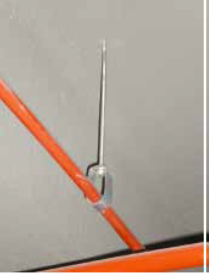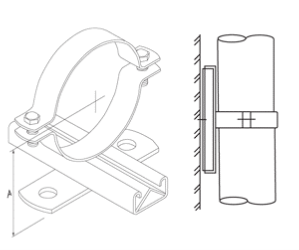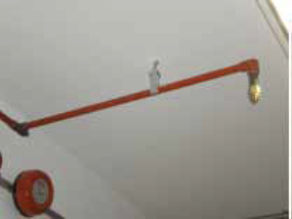 Spotted recently on a brand-new CO2 installation: sling hangers supporting gas pipes. These should not be done. CO2 discharges at 51.7 bar, the speed and movement of the gas down the pipe can cause the pipe to move around and possibly be dislodged with this type of hanger.
Spotted recently on a brand-new CO2 installation: sling hangers supporting gas pipes. These should not be done. CO2 discharges at 51.7 bar, the speed and movement of the gas down the pipe can cause the pipe to move around and possibly be dislodged with this type of hanger.
All gas suppression systems operate via high-pressure pipe lines.
Pressure from 24 bar to in-excess of 300 bar can be expected when any Clean Agent Gas system is discharged.

As the gas flows down the pipe, high levels of friction occur and gas can be discharged at anything up to 65 bar. For this reason, rigid fixing of pipes is essential. Sling-type hangers, as supplied with sprinkler systems, should not be used for gas suppression systems as these allow free movement of the pipe during discharge.
Pipes and manifolds must have no lateral and vertical movement.
Clamps supported on threaded rod or clamps onto Unistrut trunking are the preferred method of fixing.
 Not enough attention is paid to correct pipe fixing. This pipe is not supported at the pressure point i.e. the nozzle and elbow
Not enough attention is paid to correct pipe fixing. This pipe is not supported at the pressure point i.e. the nozzle and elbow
Proper fixing of pipes is detailed in SANS 14520 as follows:
Distance between supports varies between 1.5 m for 15 mm pipe and 4.3 m for 100 mm pipe.
Nominal size of pipeDIN |
Maximum pipework span |
|
15 |
1.5 |
|
20 |
1.8 |
|
25 |
2.1 |
|
32 |
2.4 |
|
40 |
2.7 |
|
50 |
3.4 |
|
65 |
3.5 |
|
80 |
3.7 |
|
100 |
4.3 |
Fixing should be installed at each elbow or T-piece on the pipe as near as possible to each nozzle.
Maximum distance of fittings away from each discharge nozzle should be as follows:
< 25 mm pipe < 100 mm
> 25 mm pipe < 250 mm
